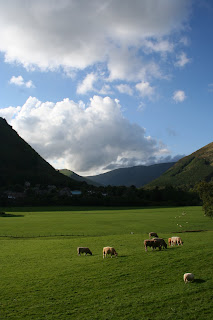
Dinas Mawddwy
Neither of us is big on itineraries…partly because we’re incapable of actually sticking to one, but mostly because they seem to be the surest way to reduce traveling to a strictly utilitarian affair.
In which case, why leave home?
After all, it’s not what we’ve planned to see, but rather what we’ve seen accidentally that we remember most poignantly. It’s the little surprises between destinations, often far off the beaten track, that make traveling among the most rewarding of all human activities. It’s all the happy little mistakes, the fortuitous wrong turns and dead ends that rigid itineraries simply do not allow for but make traveling sacrosanct.

Moel Bendinas
So we rambled north, drifting down sundry roads, through deep valleys and across long, windswept ridges.
Wales was even more beautiful than I’d hoped. Green valleys and brown peaks, flora and stone in perfect counterpoint. An almost paradoxical mixture of rugged and quaint. This apparent contradiction wasn’t manifest in just the landscape, either. It was expressed in everything from the language, to the architecture, to the very Welsh themselves.
We passed slowly through mile after mile of ridiculously scenic countryside. Through fantastic backwater villages like Pant Y Dwr, Llandinam and finally Dinas Mawddwy. Welsh villages are, as a species, remarkably picturesque. Dinas Mawddway, however, is freakishly so. Set in a narrow river valley between peaks inside Snowdonia National Park, Dinas Mawddwy is…well…perfect. Perfect on September 25, 2006, anyway.
We left the car next to Gwesty’r Llew Coch (The Red Lion Inn) on Main Street and started walking. We followed a narrow lane down into the lower valley and across the Dyfi River. We spent the rest of the afternoon and early evening wandering the larger Dinas Mawddwy area on foot.





The sun had already set behind the mountains when it finally occured to us that we hadn't found a place to spend the night yet. In the waning light, we walked back to the Red Lion Inn, hoping to score a room there...strike one. Next, the Buckley Pines Hotel...strike two. Then, the Brigand's Inn...strike three. I had pretty much resigned myself to sleeping in the car next to the woolen mill, but Shauna wanted to try one more place before giving up.
The Ty Derw (Oak House) B & B seemed the least likely place in town to have any vacancies. It was far too quaint not to have been booked months, years, decades in advance by The International Jane Austen Fan Club, or the Anne of Green Gables Appreciation Society (Welsh Chapter).
I pulled up the drive expecting to be scolded by some unnaturally stiff lady wearing an empire waist dress for having arrived so informally attired ("Will the shades of Pemberly be thus polluted?"). Instead, we were greeted by a cheery, casual English couple and a pair of truly gigantic greyhound dogs. One of them (no, not one of the dogs) asked if it would be just one room for the two of us and Shauna said "Yes!" without so much as looking at me (apparently the idea of sleeping next to the mill wasn't as romantic to her as it was to me).

Ty Derw
I have to admit, our accomodations at the Ty Derw were better than the back seat of a Vauxhall Astra. For like 6o quid we got a spacious, nicely decorated En-suite room and a pair of really, really comfortable twin beds; by far the best lodging value of our trip.
Of all the places I've ever been, Dinas Mawddwy, Mid-Wales, is my single favorite. I often imagine myself there, in that deep green valley between rocky peaks, next to the quietly chattering Dyfi River. It's ancient waters whispering the same words it uttered to a thousand generations of my ancestors. I cannot imagine a place more ideallic. If I were to wander the earth from this day to my last, I would not expect to find a place where I felt more instantly at home.
I can say very few things with any degree of authority, but, of this I am certain...I will return to Dinas Mawddwy.




































